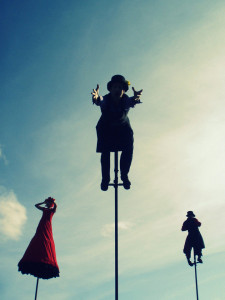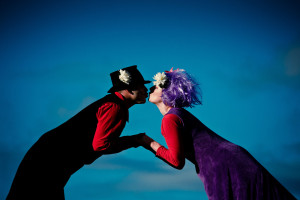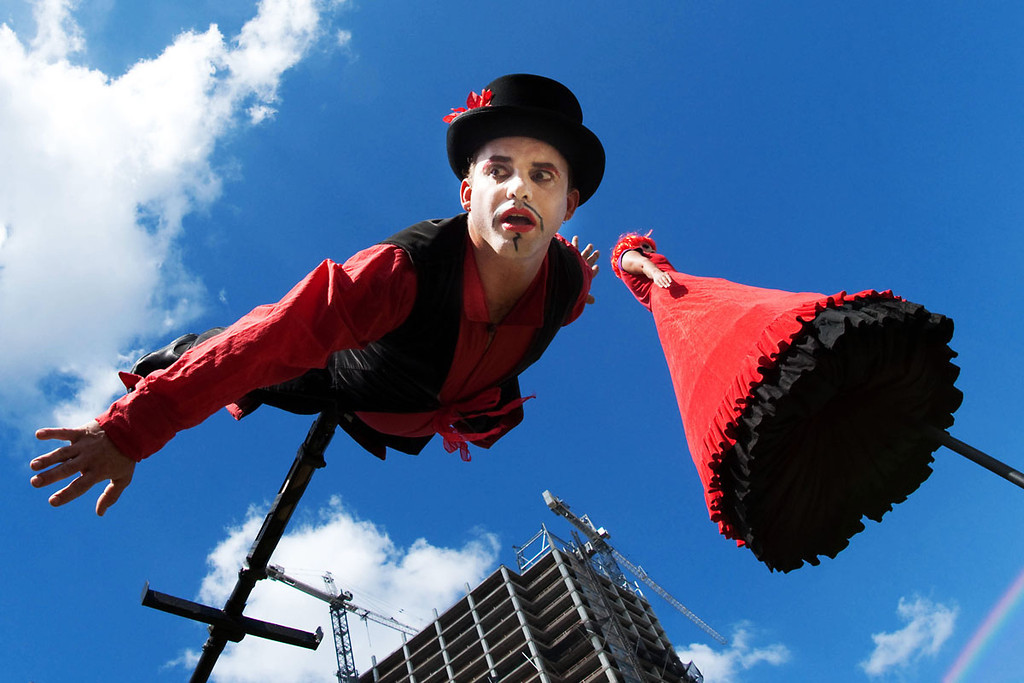Twice each evening during the Utah Arts Festival with a soundtrack that includes musical excerpts from Mozart to swing, four performers will act out a universally approachable timeless story of a boy and girl in romance, expressing love, loss, jealousy and joy. However, the quartet of performers will be dancing, flirting and adding comic gestures while atop specially made flexible fiberglass poles reaching more than 15 feet high.Australia’s Strange Fruit, the aerial performing troupe which originated in Melbourne, Australia nearly 20 years ago, will present ‘Swoon’ nightly at 6 and 8 each day of the festival, which runs June 26-29. At any one time, groups of the company’s performers likely are doing shows in countries on three continents. Australia’s Strange Fruit is unique not just for its capacity to perform at a tricky elevated level but also for how performers cultivate a choreographic process that arises from what Nami Hall, the company’s associate director, explains, a nuanced, subtle ensemble of communicating nonverbally and reading and responding to each other’s body movements. Each performance, Hall says, represents an “organic process” that is suggested by something specific about the event and the location venue, which has included, for example, a floating stage in Yeosu, Korea at the 2012 World Expo for a show titled ‘The Living Ocean and Coast.’ Hall describes ‘Swoon,’ which has been performed in 17 other countries, as “classically pure entertainment.”
Australia’s Strange Fruit performers, who range in age from the early twenties to the 50s, must maintain a rigorous health, diet and fitness regimen, being always mindful of keeping their weight at a specific level, since the poles used in performance are tailored specifically to the individual. Performers, who climb the poles without any assistance, are highly disciplined in exercise, with many using Pilates and other workout activities which enhance an individual’s flexibility, build strength and develop the body’s capacity for control and endurance. Most performers are in their late 20s or early 30s.

The audition process is extensive, Hall explains. “We accept very few numbers of people,” she says. “The first determinant is to observe if the person is focused enough for the demands of performing. And, then, of course, we have to see if they can climb the pole unassisted, and 60 percent of the applicants are out the door at that point.”
Then, Hall says, the company can immediately see if a potential performer is comfortable at the heights and can begin to communicate and express motion effectively. Circus performers, not surprisingly, are naturally inclined to gaining that right sense of freedom for the dance and theatrical movements which are central to making Strange Fruit’s repertoire work so well in performance.

Audience response to Australia’s Strange Fruit’s shows is pretty much consistent from country to country and continent to continent, Hall says, mainly because the performers can bend toward audiences and the spontaneity of seeing an audience member’s facial expression or reaction fuels the vibe and feel of the show. However, Hall says there can be a “Catch-22” in seeing the number of spectators who record video and snap photos on their mobile phones and tablets, sending them immediately with hashtags to Twitter, Instagram, Facebook and other spontaneous channels of social media communication. “Since we rely heavily on word of mouth about our shows, we appreciate the enthusiasm of audiences who can share their experience so rapidly,” she explains, “but then we also see the backs of phones and tablets when instead we would prefer to see the direct reaction on a spectator’s face.” Hall’s point is notable because while one of the direct performance benefits of Australia’s Strange Fruit is to shatter the barrier between performer and audience, the easily accessible technology that allows audiences to share the joy of the show places a bit more distance.

Australia’s Strange Fruit also is sensitive to cultural norms and gestures that might seem appropriate in one country but not in another. For example in countries which are predominantly Muslim, Australia’s Strange Fruit would take out gestures of kissing and hugging, replacing them instead with mimed movement to suggest what is happening. In Malaysia, pointing with a finger is considered offensive, so the gesture instead would be to point with the thumb.
Hall says Australia’s Strange Fruit’s timeless appeal is connected somewhat to nostalgia about older circus performing troupes which would come into town, set up, do the show in a community public space, tear down, and leave without a trace that they ever were there. Australia’s Strange Fruit operates much the same way. “We love the fact that everybody can see our show,” she explains, recalling a memorable performance in Massachusetts which some homeless people were able to see as well as those who were watching from windows in a building across the street. Indeed, the company requires no formal marketing or promotional program. The simple laughter and joys of expression on spectator faces, of all ages, have proven to be the best word-of-mouth for a group that finds grace at a tricky yet fully satisfying elevated medium.
Australia’s Strange Fruit – “Swoon” from Elsie Management on Vimeo.


